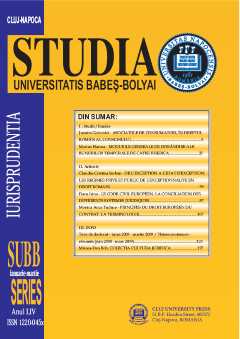REFLECŢII ASUPRA INFRACŢIUNILOR PREVĂZUTE DE ALIN. (1) ŞI (2) ALE ART. 92 DIN OUG 195/2002 PRIVIND CIRCULAŢIA PE DRUMURILE PUBLICE
ON THE OFFENCES PROVIDED BY ARTICLE 92TH OF THE GOVERNMENT’S ORDINANCE NO. 195/2002 REGARDING ROAD TRAFFIC
Author(s): Ionuţ BorlanSubject(s): Law, Constitution, Jurisprudence
Published by: Studia Universitatis Babes-Bolyai
Keywords: road traffic; theft; destruction; road obstacles; road facilities; means of signaling; Government’s Ordinance no. 195/2002.
Summary/Abstract: On the offences provided by article 92th of the Government’s Ordinance No. 195/2002 regarding road traffic. The author analyzes two of the five offences provided by the above mentioned legal provisions, which imply several law issues that are worth mentioned. However, as we shall see, the first paragraph covers in fact two independent offences, although at first glance the rule does not expressly state this. The first analyzed paragraph commerce by indicating the text of incrimination on which the author supports his study and by stating some general assessments regarding these offences for a better understanding of the text. Given that the crime provided by paragraph 1 regarding the objective aspect shows some similarities with some other offences provided by the Romanian Criminal Code (such as those of theft and malicious destruction of property), the author tries to determine the application criteria for each of these incrimination texts and in which situations some will have priority over other. On the second offence governed by the same paragraph mentioned above, the author tries to explain the meaning of the incrimination text and its scope. The text presents various legislative deficiencies with legal effect on criminal liability and the obligations of drivers who create obstacles on the carriageway. If the obstacles were created intentionally the criminal text can be applied, but if they were created by fault and the driver did not signal the obstacles, it can be said that he accepted the possibility of other cars crashing into them. However, in this case, the law does not sanction this act as a crime, but as a misdemeanor. Regarding the last offence provided by paragraph 2, the author presents some general remarks on its application. The text of incrimination provides two ways of committing the crime, but does not give any special means to identify each other. Since both methods are punished in the same way, the difference between these two remains at a theoretical level. Nevertheless, it is a matter of legal classification, for which reason these methods are analyzed from two perspectives, subjective and objective through which they can be differentiated.
Journal: Studia Universitatis Babes Bolyai - Iurisprudentia
- Issue Year: 57/2012
- Issue No: 3
- Page Range: 49-60
- Page Count: 12
- Language: Romanian

